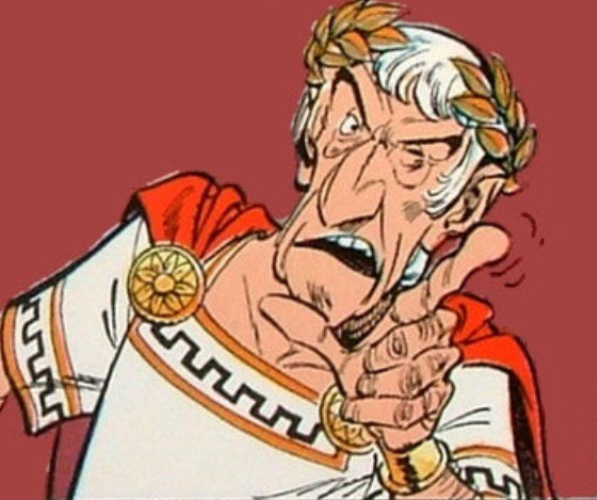

By John Helmer, Moscow
@bears_with
In imperial history there is nothing new in cases of dementia in rulers attracting homicidal psychopaths to replace them. It’s as natural as honey attracts bees.
When US President Woodrow Wilson was incapacitated by a stroke on October 19, 1919, he was partially paralysed and blinded, and was no longer able to feed himself, sign his name, or speak normally; he was not demented.
While his wife and the Navy officer who was his personal physician concealed his condition, there is no evidence that either Edith Wilson or Admiral Cary Grayson were themselves clinical cases of disability, delusion, or derangement. They were simply liars driven by the ambition to hold on to the power of the president’s office and deceive everyone who got in their way.
The White House is always full of people like that. The 25th Amendment to the US Constitution is meant to put a damper on their homicidal tendencies.
What is unusual, probably exceptional in the current case of President Joseph Biden, not to mention the history of the United States, is the extent of the president’s personal incapacitation; combined with the clinical evidence of psychopathology in his Secretary of State Antony Blinken; and the delusional condition of the rivals to replace Biden, including Donald Trump and Hillary Clinton.
Like Rome during the first century AD, Washington is now in the ailing emperor-homicidal legionary phase. But give it another century or two, and the madness, bloodshed, and lies of the characters of the moment won’t matter quite as much as their images on display in the museums of their successors craving legitimacy, or of successor powers celebrating their superiority.
Exactly this has happened to the original Caesars, as a new book by Mary Beard, a Cambridge University professor of classics, explains. The biggest point of her book, she says, is “dynastic succession” – not only of the original Romans but of those modern rulers who acquired the Roman portraits in marble and later copies in paint, and the copies of those copies, with the idea of communicating “the idea of the direct transfer of power from ancient Romans to Franks and on to later German rulers.”
In the case she narrates of the most famous English owner of a series of the “Twelve Caesars”, King Charles I — instigator of the civil war of 1642-51 and the loser of both the war and his head – the display of his Caesars was intended to demonstrate the king’s self-serving “missing link” between his one-man rule and the ancient Romans who murdered their way to rule, and then apotheosized into immortal gods in what they hoped would be a natural death on a comfortable bed.
With the American and Russian successions due to take place in Washington and Moscow in two years’ time, Beard’s “Twelve Caesars, Images of Power from the Ancient World to the Modern”, is just the ticket from now to then.
Before the ill-fated Charles acquired (by fraud) his Twelve Caesars by Titian, Beard tells the story of the most famous set of gold and silver dishes depicting the Twelve Caesars, a 16th century Italian creation called after one of its owners, the Aldobrandini Tazze. Each of the set, composing a Caesar statuette screwed on to a bowl screwed on to a display stand, has long been the object of mistakes of emperor and history. The technical cause has been the unscrewing of the emperors during cleaning, and the rescrewing of the wrong Caesar on to the wrong plate stand.
The historical cause is that between 121 AD, when Suetonius published his history from Julius Caesar (d.44 BC) to Domitian (d. 96 AD) De Vita Caesarum , aka The Twelve Caesars, and now, two millennia later, the depiction of Caesar’s power, the names, the abuses, the bloodshed and the truth, make no difference at all to the celebration — and that’s of power itself.

Mary Beard; the new book; the emperor Vespasian on his dish in the Aldobrandini set, now owned by the Metropolitan Museum of New York.
King Charles’ Caesars were painted canvases by Titian. Heir of the winner of the English civil war a century before, Henry VIII commissioned a series of woven tapestries on the theme of Julius Caesar’s career killing his way through Gaul, then Italy, and then being killed himself. That collection was, reports Beard, “a visual depiction of civil war…a series of depictions of the dark epic conflict that heralded one-man rule in Rome, and paved the way for a dictatorship that ended with Caesar’s assassination.” “Was there a lesson in this?” Beard asks.
Her richly illustrated answer is that although the fashionableness has come and gone of depicting rulers, aristocrats and the rich of one era in the costume, and marble, metal or painted images of ancient Rome, “there was always liable to be a reputational risk in looking too much like a particular member of the Roman imperial family… It is hard to escape the awkward fact that to be represented as a Roman in the modern world is almost bound to carry with it whiffs of autocracy.”
Since only two of Suetonius’ twelve Caesars died natural deaths, Augustus and Vespasian (and only Vespasian’s natural cause, diarrhea, is a certainty), the “images of the power of Roman emperors have always gone hand in hand with their personal vices – and the systemic corruption of the imperial regime of which those vices were a symbol. That idea was written indelibly into the history of Christianity… But it extends in different directions much further than religion.”
This hasn’t had anything like the run in Russian political history, or even the history of Russian art and fashion, that has characterised the parallel European as well as American history. Beard’s book mentions only one Russian tsar and one Russian artist in her story of the Twelve Caesars. They are Tsar Alexander III who in 1887 bought Vasily Smirnov’s painting of that year, The Death of Nero.
The Suetonius story, which Smirnov followed, was of Emperor Nero, condemned by the Senate, abandoned by the army, and deserted by his household, who was helped in killing himself by a slave. According to Beard, “if there is one painting that represents more cleverly and successfully than any other the capacity of nineteenth-century artists to probe critically the nature and foundation of the imperial system,” it is this picture of Smirnov’s.
That Alexander III bought it, Beard comments, “might seem at first odd choice for a monarch. But perhaps he, like Henry VIII, enjoyed this prompt to reflect on the complexities and difficulties of one-man rule.”
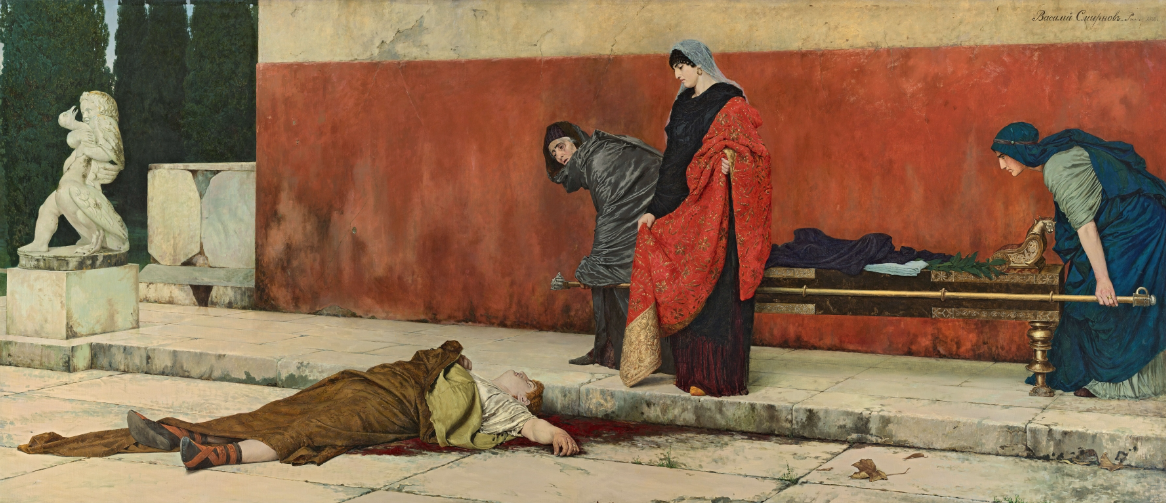
The Death of Nero by Vasily Smirnov from the Russian state collection in the Mikhailovsky Palace, St. Petersburg.
Beard appears not to have known that Smirnov painted, and the tsar bought this painting, just six years after Alexander II, the tsar’s father, had been assassinated in St. Petersburg. It was to be another 13 years before Nicholas II, Alexander’s son, was executed during the Russian civil war.
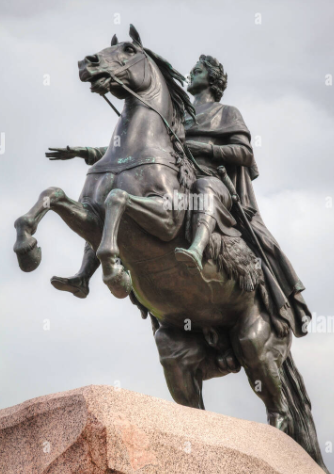
Smirnov was well aware, however, that a hundred years before he painted Nero, the equestrian statue of Tsar Peter I, the Great, was created and installed in 1782 in St. Petersburg on the commission of Empress Catherine II. She intended it to display in public the continuity of imperial rule from Peter to herself (obscuring the murder by which she took it). There appear to be no other sculpted or painted images of the tsar in public showing Peter in Roman costume.
From Catherine’s fancy to Alexander III’s taste, and through the 20th century, no other public statues have been found, nor paintings displayed publicly, of Russian rulers in Roman imperial garb. By contrast, the British kept showing their monarchs in Roman togs until 1808, when a bronze George IV was installed in St. James Square on a horse like Peter’s; and then in 1847 when a marble Queen Victoria was stood up without a horse inside Buckingham Palace.
Not long before, a marble George Washington had been installed in the Capitol on the order of the US Congress. But the congressmen went one better than the British, portraying Washington as the Greek god Zeus.
These images, the imperial analogies, and the doctrine of divine succession have been impossible in post-revolutionary Russia. When Joseph Stalin was reportedly compared to Tsar Ivan IV, the Terrible (d.1584, stroke), he replied: “Every analogy is lame.”
Actually, Stalin was repeating word for word Vladimir Lenin’s statement, written in February 1922 in an essay, “On Ascending a High Mountain”, published in Pravda on April 16, 1924 Lenin wasn’t comparing himself. His idea was: “An analogy is not proof. Every analogy is lame. These are incontrovertible and common truths; but it would do no harm to recall them in order to see the limits of every analogy more clearly.” Since Lenin started the sentence, it has become a common one in Russian.
Recently, the Roman emperor analogy has been started up – by Russian monarchists who want to depict President Vladimir Putin as the first of a new line; by hucksters trying to capitalize on the president’s popularity by merchandising his image; and by enemies of Russia who want to propagandize their war for regime change in the Kremlin by personalizing Putin as one of Suetonius’ nastiest characters.
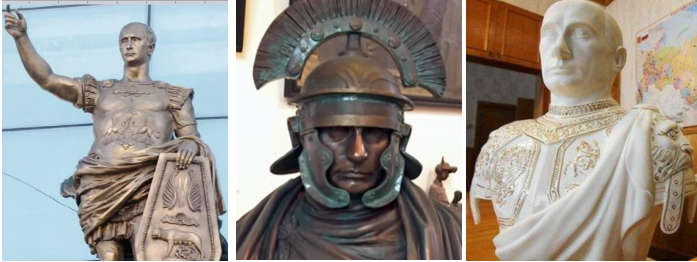
Sources: left, https://www.yugopolis.ru/9 Centre and right: https://twitter.com/juliadavisnews

Source: https://www.rferl.org/
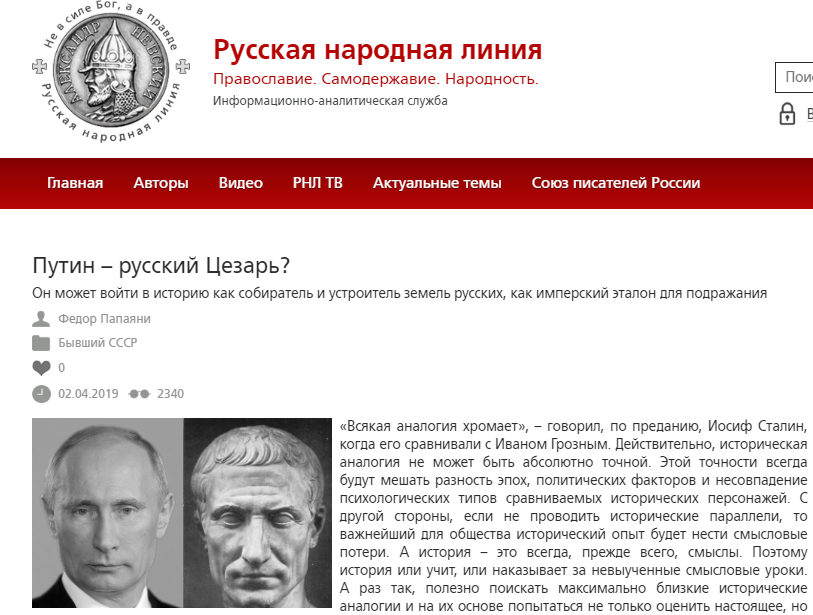
Source: https://ruskline.ru/
One of the rare attempts by a contemporary Russian historian to defy Lenin’s warning and attempt to draw parallels between the ancient Romans and Putin is Feodor Papayani, an academic based in Donetsk, in the Donetsk People’s Republic. In his essay, published in April 2019, he wrote that “between Putin and Caesar, if you compare them by the criterion of the idea of power, you can really find a lot of similarities, and more than with anyone else: both as leaders were born in democracy and tried to stay within the framework of existing legislation, without radically changing (although correcting, reforming) the inherited rules of the democratic political ‘game’; both are grandmasters of politics and geopolitics, beating their opponents with precise calculation, competent, precise, often unexpected, ‘non-symmetrical’ moves and strikes. Both seem to demonstrate the session of a simultaneous intellectual game by a grand master, playing several political opponents at once. Both have achieved military successes abroad (Caesar – in Gaul, Putin – in Syria).”
“Both tried to accommodate the oligarchs, to put them at the service of the state, influencing them, as far as possible, with the soft power of persuasion. Caesar during the first triumvirate (i.e., the ‘union of three husbands’) ruled together with the richest Roman oligarch Marcus Licinius Crassus. Putin attached Russian oligarchs (‘the Chubais collective’) to a lucrative state service or provided the latter with profitable state orders. Both conducted their political activities in the conditions of the civil war. The fate of both is directly dependent on its outcome. Caesar did not have time to solve this political problem, leaving it to his successors. To the credit of the latter, the Caesarians coped with this task. As for Putin and his successors, it will be seen in the years to come, while the Russian world is suffering losses due to the Russophobic turmoil organized by the West throughout the post-Soviet space. Note that Putin stopped the war in Chechnya, but in general, the situation with the civil war is much more complicated than it was with Caesar. The war against branches of the Russian people in the Donbass… is fueled by all the power (financial, political, technological, informational) of the united West led by the United States. How it is possible to overcome the Russophobic turmoil without stopping the United States is not yet clear to anyone.”
Papayani says he is hoping for a monarchical succession to Putin in Moscow, not the dynastical type in Washington.
Writing in Washington last year, Beard concludes: “it should come as a relief to most of us that we are probably no worse at matching up the correct imperial names with the correct imperial faces than people in general have ever been. In fact, part of the dynamic fun of the images of the Caesars, part of the reason for their visual longevity, is that that they are so hard to pin down. They are not a breed of iconographic fossils.”











Leave a Reply